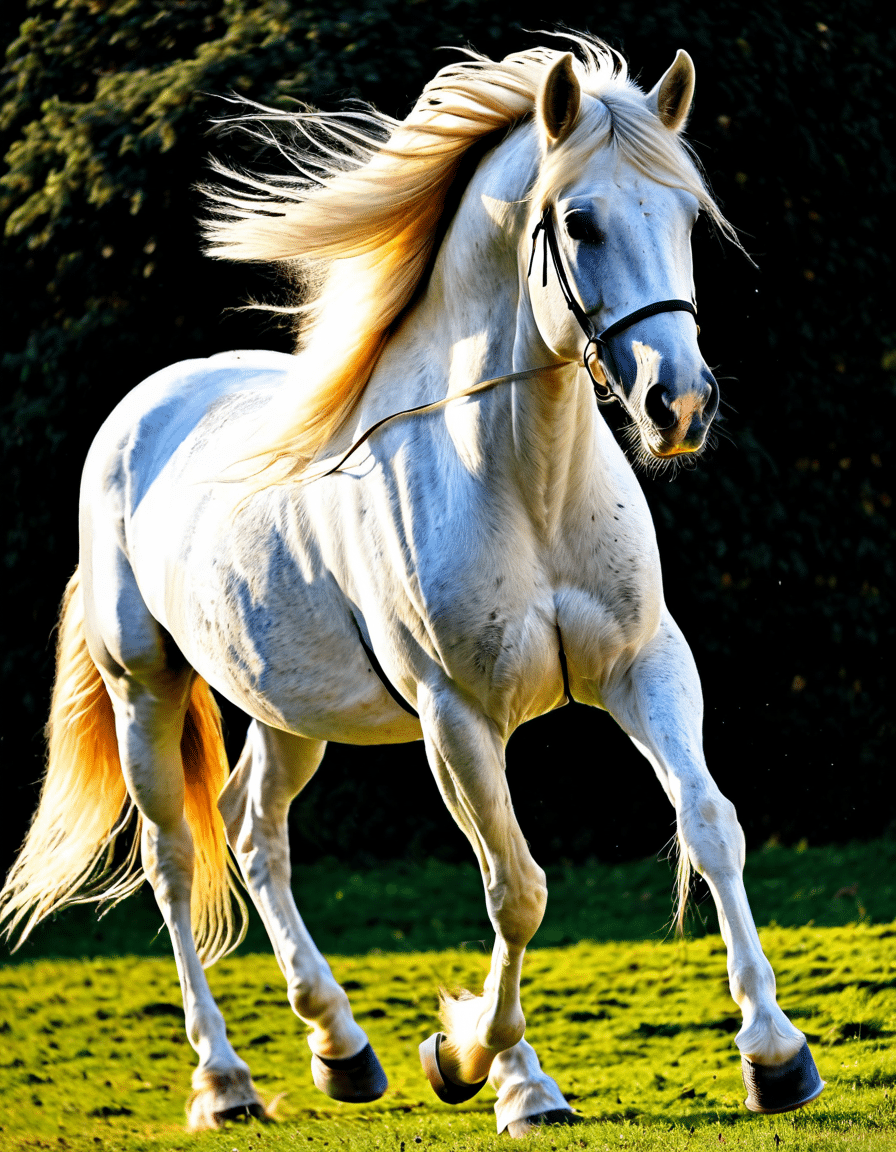What a Male Horse is Called: The Majestic Stallion and Its Significance
When you think about a male horse, the term that stands out is “stallion.” This word doesn’t just signify a male horse; it embodies strength, beauty, and prowess. Stallions are uncastrated male horses over three years old, playing a crucial role in breeding programs due to their genetic contributions. They symbolize a fierce spirit in various equestrian disciplines, making it vital for horse owners and enthusiasts to understand not just the terminology but the stallion’s role in both breeding and behavior.
The majestic stallion isn’t merely a title; it reflects a rich legacy in horse culture. Understanding this classification allows us to appreciate how it differs from other male horses, like geldings (castrated males) and mares (females). Stallions tend to showcase a more spirited nature, often driven by a strong instinct and temperament, which can vary widely based on breeding and environmental factors.
Moreover, recognizing the importance of stallions can influence breeding decisions, training methods, and handling techniques. Knowing the behaviors and attributes of a stallion can help horse owners create better environments for these magnificent creatures, whether on a farm, in competitive arenas, or even at home.

The Noble Stallion: Characteristics and Traits
a. Temperament and Behavior
Stallions often come with their own personalities. Their temperament ranges from calm and agreeable to fiery and aggressive, heavily influenced by their upbringing and genetics. Ideally, stallions should receive early training and socialization to avoid potential behavioral challenges. A well-trained stallion will be more manageable, while those lacking proper guidance can exhibit problematic behaviors.
Training a stallion demands patience and understanding. Horses are naturally herd animals, and a stallion that feels threatened can display aggressive behaviors. Proper socialization, starting from a young age, not only helps mitigate these challenges but also harnesses their energy positively during training.
b. Breeding and Genetic Contributions
Stallions play a pivotal role in breeding programs, as their genetic material can create desired traits that breeders aim for in new generations. For instance, thoroughbred stallions are often selected for qualities like speed and endurance. In contrast, draft stallions are preferred for their physical strength and size, vital attributes in many equestrian pursuits.
The genetic contributions of a stallion have a lasting impact on the horse industry, shaping not just the individual horse but the traits passed down through generations. It is this significant role that makes understanding the breeding practices surrounding stallions crucial for any aspiring breeder or equine enthusiast.
Stallions vs. Other Male Horses
a. Gelding vs. Stallion Dynamics
Differentiating between a stallion and a gelding is essential. Geldings often exhibit more manageable behaviors because they lack testosterone, which can lead to the fiery temperament sometimes found in stallions. This can make geldings more suitable for novice riders or those looking for a more docile companion.
However, the spirited nature of stallions can be a definite advantage in competitive settings. Their vigor and athleticism often shine through in show jumping, racing, and other equestrian sporting events, showcasing a level of energy that many riders seek.
b. The Role of Prominent Breeds
Many prominent horse breeds boast famous stallions that illustrate these traits. For instance, Buchan’s Secretariats presented unparalleled speed which transformed perceptions of racing stallions.
Another example is Seattle Slew, noted for being the last horse to win the Triple Crown while undefeated. The achievements and qualities of these legendary stallions significantly influence breeding decisions, showcasing how individual stallions can impact entire breeds.

Stallion Care and Management
Maintaining a stallion’s health, performance, and vitality revolves around effective training, nutrition, and management. Such performance-oriented care ensures these powerful animals thrive:
Moreover, it’s essential to provide a safe, structured environment where stallions can thrive. Mutually beneficial relationships develop over time with proper care and attention, leading to better training outcomes.
Unique Equines: Small Breeds and Their Stallions
While the term ‘stallion’ often conjures images of large breeds, there are small breeds of horses that also have male horses referred to as stallions. The Falabella, for instance, is a small breed known for its charm and unique appearances. Despite their size, these diminutive equines possess individual personalities and characteristics that remind us that stallion status isn’t limited to larger breeds.
This concept parallels how we view a small breed of dogs with short hair, like the French Bulldog, which showcases agility and exuberance despite their compact stature. Recognizing that stallion status can encompass various breeds broadens our understanding and appreciation of these fascinating animals.
Stallions in Popular Culture
Stallions have secured their place in popular culture, often serving as symbols of freedom and grace. Films like “Spirit: Stallion of the Cimarron” depict their majestic power, resonating with audiences of all ages. These portrayals highlight the dynamic bond between humans and horses, offering reflections of companionship through engaging storytelling.
Additionally, advertisements often spotlight stallions, emphasizing elegance, beauty, and strength. This cultural significance contributes to their allure, setting them apart as iconic representations of the equestrian world.
Understanding Horse Size: The Belly Size of Pregnant Cat Trimester for Comparison
Interestingly, drawing parallels between stallions and a fascinating aspect of pet care, such as the belly size of a pregnant cat during different trimesters, adds depth to our understanding of growth across species. Just like stallions evolve significantly as they mature, a pregnant cat’s belly expands in notable ways each trimester, reflecting the journeys of growth and nurturing in the animal kingdom.
A cat breed with a flat face, like the Persian, might highlight how species adapt and evolve. Grasping these development processes enriches the experience for pet care enthusiasts, enhancing connection and promoting knowledge across species.
A Majestic Legacy Continues
The stallion embodies equine nobility, representing a blend of individual personality, behavior, and significance within human culture. Appreciating these aspects allows horse enthusiasts to connect more deeply with their equine partners. Understanding the historical importance of stallions serves as a reminder of their vital contributions to horse breeds and training practices, linking us through a tapestry woven with strands of companionship and adventure.
As we explore the legendary status of the majestic stallion, it becomes clear that their importance stretches beyond simple definitions. The legacy of stallions captivates us, affirming their timeless place in our hearts and lives, encouraging ongoing admiration and respect for these magnificent creatures.
What a Male Horse is Called: The Majestic Stallion
When talking about horses, you might hear the term “stallion” quite often. So, what’s the big deal about a male horse? Well, stallions are not just any male horses; they are often uncastrated and play a vital role in breeding. If you’re curious about how they differ from other horse types, like geldings or mares, you’re in for a treat! Did you know that stallions can weigh anywhere from 900 to over 1,200 pounds? That’s like lifting a couple of collie dog puppies at once! And when it comes to strength, they don’t back down—even when facing minor injuries. Some horse owners have turned to herbal Painkillers For Dogs as a natural solution for managing pain, indicating a holistic approach that could be expanding to equine care too.
Stallions: An Insight into Their Behavior and Traits
Stallions are commonly known for their powerful demeanor and spirited nature. They have an impressive instinct to protect their herd, often displaying strong leadership qualities. Fun fact—while you might think of them as fierce, they can also be affectionate companions. Imagine trying to train a stallion—it’s a challenge that requires patience and understanding, kind of like getting a dog used to travel in their dog crate. Their behavior can sometimes reflect the relationship they have with their trainers, which includes a lesson on trust. Fun trivia: Stallions can even be trained for different disciplines, be it jumping, dressage, or western riding!
Nature and Nurture: Stallions in the Wild
In the wild, stallions usually lead a band of mares and their offspring, showcasing their role as protectors. However, they also often face challenges from rival stallions—an ongoing battle for leadership that keeps them on their toes. This competitive spirit isn’t just about survival; it’s akin to how players in Games like It Takes Two navigate through challenges, leveraging their strengths. When stallions are raised in a controlled environment, such as ranches or farms, they often bond closely with humans, resulting in some stunning partnerships. These relationships remind us of the way we bond with our pets, like how we ensure our kittens drink water regularly to keep them healthy!
So, there you have it! The male horse is called a stallion and embodies a remarkable presence in equine culture. Whether you’re a seasoned horse enthusiast or just a curious cat, there’s a world of wonder in these majestic creatures. If you think about it, each stallion has stories of its lineage, just like those tales swirling around every modern Toyota on the street!



